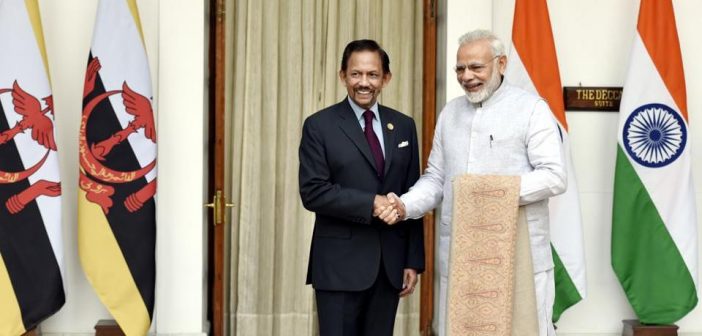India’s Act East Policy, first launched in the early 1990s, has evolved into a central pillar of the country’s foreign policy under Prime Minister Narendra Modi. The policy is designed to strengthen India’s economic, political, and strategic ties with the countries of Southeast Asia, East Asia, and the Indo-Pacific region. As Modi prepares for his upcoming visit to Brunei, this policy’s relevance is highlighted, especially concerning India’s economic ambitions, defense collaborations, and strategic positioning in a rapidly changing geopolitical landscape.
Economic Engagement: Expanding Trade and Connectivity
Economic engagement is a cornerstone of the Act East Policy. India seeks to bolster trade relations with ASEAN (Association of Southeast Asian Nations) members, leveraging these partnerships to enhance regional economic growth. During the fiscal year 2023-24, trade between India and ASEAN countries was recorded at approximately USD 122.67 billion, showcasing a significant economic interdependence. India’s efforts are further emphasized through various infrastructural projects, such as the India-Myanmar-Thailand Trilateral Highway and the Kaladan Multimodal Transit Transport Project. These projects aim to improve connectivity and facilitate smoother trade routes within the region, although they have faced delays due to political instability and the COVID-19 pandemic.
The upcoming visit to Brunei and other ASEAN countries underscores India’s commitment to strengthening these economic ties. Brunei, a nation rich in oil and gas resources, presents opportunities for India to diversify its energy supply sources. Additionally, stronger economic relations with ASEAN could help India integrate into the regional supply chains, boosting its manufacturing sector and creating job opportunities domestically.
Defense and Security: Strategic Counterbalance to China’s Influence
India’s Act East Policy also has significant defense and security dimensions. The increasing assertiveness of China in the South China Sea and its growing presence in the Indian Ocean region have prompted India to seek stronger security partnerships with ASEAN countries. This strategic move aims to counterbalance China’s influence and assert India’s role as a regional security provider. The Act East Policy has seen India engage in various defense collaborations, including joint naval exercises and capacity-building initiatives with countries like Vietnam, Indonesia, and the Philippines.
During Modi’s visit, discussions are expected to focus on enhancing defense cooperation, maritime security, and intelligence sharing. By strengthening military ties with ASEAN countries, India aims to ensure a stable and secure Indo-Pacific region, crucial for the free flow of trade and maintaining regional peace.
Diplomatic Relations: Building Regional Influence
The Act East Policy serves as a diplomatic tool for India to expand its influence in Southeast Asia and beyond. By fostering closer ties with ASEAN countries, India aims to position itself as a key player in regional forums such as the East Asia Summit, where it can voice its perspectives on critical issues, including territorial disputes and regional security dynamics. This diplomatic engagement helps India project its soft power, emphasizing shared cultural, historical, and civilizational ties with Southeast Asia.
Modi’s visit to Brunei and other ASEAN countries reaffirms India’s commitment to the Act East Policy. It is an opportunity for India to strengthen diplomatic relations, address mutual concerns, and build a coalition of like-minded countries committed to maintaining a rules-based international order. This aligns with India’s broader foreign policy objectives of promoting a multipolar world and safeguarding its strategic autonomy.
Challenges and Future Prospects
While the Act East Policy has achieved notable successes, challenges remain. One of the main criticisms from ASEAN countries is the perceived lack of robustness in India’s economic engagement. Despite growing trade volumes, India’s economic footprint in the region is still overshadowed by China’s dominant presence. Additionally, delays in executing key connectivity projects have hampered India’s ability to fully capitalize on economic opportunities in the region.
Moreover, India’s diplomatic balancing act between the US and China adds complexity to its regional strategy. While India seeks to counter China’s influence, it must navigate this landscape without overtly aligning with either power, to avoid being caught in the crosshairs of great power competition.
Looking ahead, India’s success in the region will depend on its ability to deliver on promises of economic cooperation, implement infrastructural projects efficiently, and maintain a consistent and proactive engagement strategy. As Prime Minister Modi prepares for his visit to Brunei, the Act East Policy’s significance is more apparent than ever, marking India’s strategic pivot towards Southeast Asia and the Indo-Pacific region.





